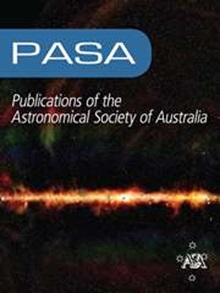Low-frequency pulse-jitter measurement with the uGMRT I : PSR J0437–4715
IF 4.6
3区 物理与天体物理
Q1 ASTRONOMY & ASTROPHYSICS
Publications of the Astronomical Society of Australia
Pub Date : 2024-04-16
DOI:10.1017/pasa.2024.30
引用次数: 0
Abstract
High-precision pulsar timing observations are limited in their accuracy by the jitter noise that appears in the arrival time of pulses. Therefore, it is important to systematically characterise the amplitude of the jitter noise and its variation with frequency. In this paper, we provide jitter measurements from low-frequency wideband observations of PSR J0437–4715 using data obtained as part of the Indian Pulsar Timing Array experiment. We were able to detect jitter in both the 300 - 500 MHz and 1260 - 1460 MHz observations of the upgraded Giant Metrewave Radio Telescope (uGMRT). The former is the first jitter measurement for this pulsar below 700 MHz, and the latter is in good agreement with results from previous studies. In addition, at 300 - 500 MHz, we investigated the frequency dependence of the jitter by calculating the jitter for each sub-banded arrival time of pulses. We found that the jitter amplitude increases with frequency. This trend is opposite as compared to previous studies, indicating that there is a turnover at intermediate frequencies. It will be possible to investigate this in more detail with uGMRT observations at 550 - 750 MHz and future high sensitive wideband observations from next generation telescopes, such as the Square Kilometre Array. We also explored the effect of jitter on the high precision dispersion measure (DM) measurements derived from short duration observations. We find that even though the DM precision will be better at lower frequencies due to the smaller amplitude of jitter noise, it will limit the DM precision for high signal-to-noise observations, which are of short durations. This limitation can be overcome by integrating for a long enough duration optimised for a given pulsar.利用 uGMRT I 测量低频脉冲抖动:PSR J0437-4715
高精度脉冲星定时观测的精度受到脉冲到达时间中出现的抖动噪声的限制。因此,系统地描述抖动噪声的振幅及其随频率的变化非常重要。在本文中,我们利用印度脉冲星定时阵列实验获得的数据,对 PSR J0437-4715 进行了低频宽带观测,并提供了抖动测量结果。我们能够在升级版巨型移波射电望远镜(uGMRT)的 300 - 500 MHz 和 1260 - 1460 MHz 观测中探测到抖动。前者是首次在 700 MHz 以下对该脉冲星进行的抖动测量,后者与之前的研究结果非常吻合。此外,在 300 - 500 MHz 波段,我们通过计算每个子波段脉冲到达时间的抖动,研究了抖动的频率依赖性。我们发现,抖动幅度随频率的增加而增加。与之前的研究相比,这一趋势正好相反,表明在中间频率上存在一个转换。通过 uGMRT 在 550-750 MHz 的观测以及未来下一代望远镜(如平方千米阵列)的高灵敏度宽带观测,将有可能对此进行更详细的研究。我们还探讨了抖动对短时间观测得出的高精度色散测量(DM)结果的影响。我们发现,尽管由于抖动噪声的振幅较小,较低频率下的频散测量精度会更好,但它会限制高信噪比观测的频散测量精度,而高信噪比观测的持续时间较短。这种限制可以通过为特定脉冲星优化足够长的持续时间来克服。
本文章由计算机程序翻译,如有差异,请以英文原文为准。
求助全文
约1分钟内获得全文
求助全文
来源期刊
CiteScore
5.90
自引率
9.50%
发文量
41
审稿时长
>12 weeks
期刊介绍:
Publications of the Astronomical Society of Australia (PASA) publishes new and significant research in astronomy and astrophysics. PASA covers a wide range of topics within astronomy, including multi-wavelength observations, theoretical modelling, computational astronomy and visualisation. PASA also maintains its heritage of publishing results on southern hemisphere astronomy and on astronomy with Australian facilities.
PASA publishes research papers, review papers and special series on topical issues, making use of expert international reviewers and an experienced Editorial Board. As an electronic-only journal, PASA publishes paper by paper, ensuring a rapid publication rate. There are no page charges. PASA''s Editorial Board approve a certain number of papers per year to be published Open Access without a publication fee.

 求助内容:
求助内容: 应助结果提醒方式:
应助结果提醒方式:


